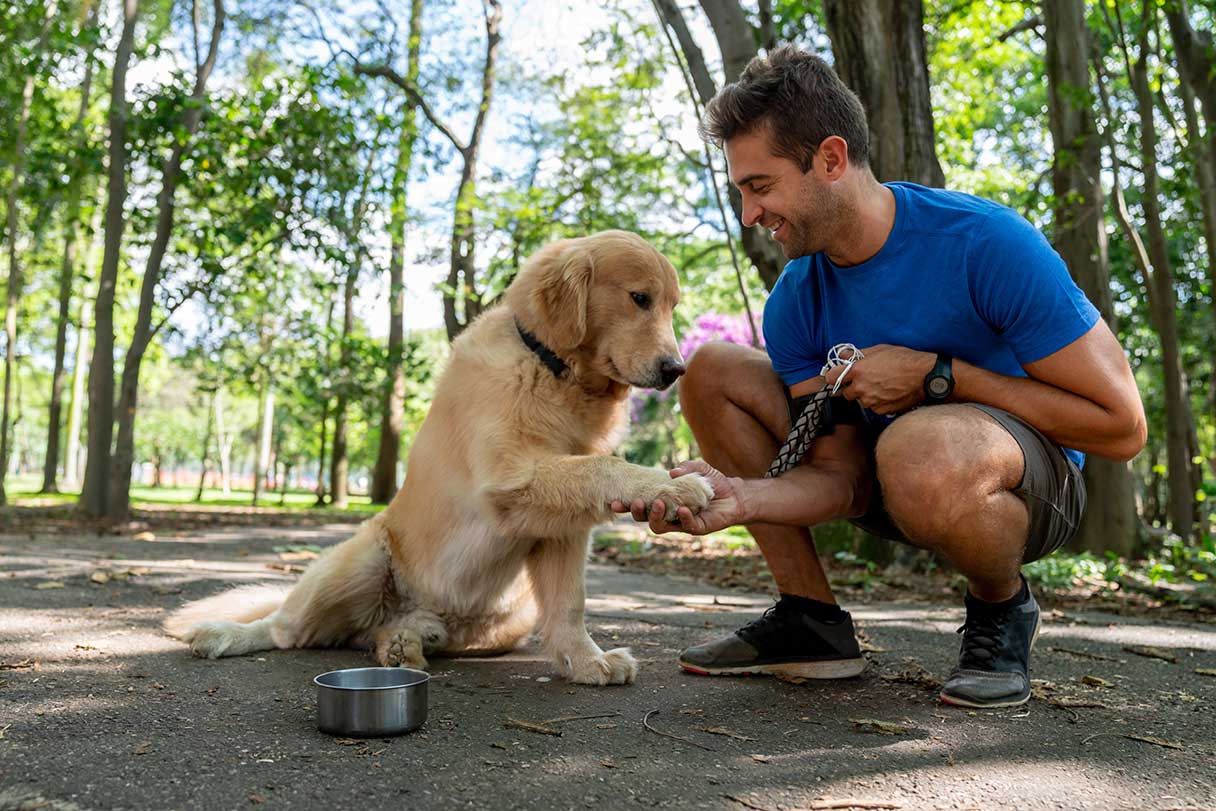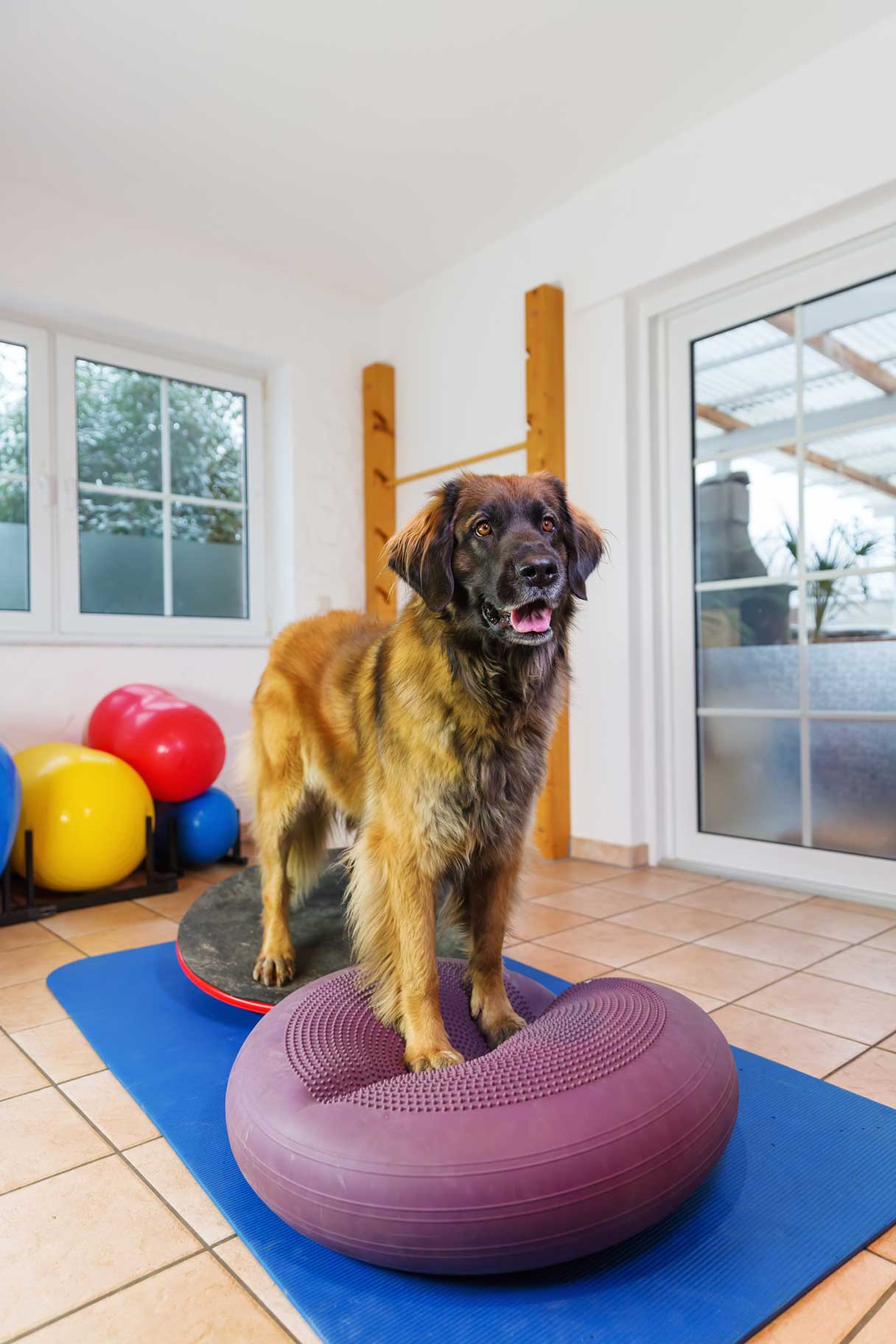More and more, pet parents regard their dogs and cats as small, furry persons and want to care for them accordingly.1 Veterinary medicine is keeping up with this increasing demand for a higher quality and wider range of options for pet healthcare, and one of those newer options is pet physical therapy (PT).2
Also known as rehabilitation therapy, this rising trend is an important addition to pet healthcare. Cats and dogs suffer many of the same physical impairments that humans do, and physical therapy can be just as beneficial to your pet as it is for a human recovering from an injury or surgical procedure, or who suffers from mobility issues due to aging or illness.
How can you tell if your dog or cat needs physical therapy? Below are some common signs that will help you know whether it's time to seek treatment.
1. They're Not Excited to Go On Walks
If your pup normally meets you at the door with their tail wagging every time you break out the leash but they no longer seem enthused about their walkies, it might be a sign that something's wrong. They might also refuse to budge or pull backward after you put the leash on them. This is a red flag warning of possible joint or muscle pain.3
2. They Avoid Running or Energetic Play
Similarly, your normally energetic pet no longer getting the zoomies or refusing to run, jump, chase their toys or be their usual rambunctious self might mean they're struggling with pain, weakness or loss of energy.
3. They're Reluctant to Climb Stairs
Both dogs and cats who have arthritis or other degenerative joint diseases tend to avoid climbing steps as much as possible. Your pet suddenly no longer wanting to follow you up or down the stairs could mean they're a good candidate for physical rehab.3
4. They Have Difficulty Getting Into or Out of the Car
If your pup who loves car rides can't seem to handle hopping or climbing in and out like they once did, this could be another sign that joint pain or musculoskeletal issues are forcing them to slow down.
5. They Have Trouble Getting Up
A healthy dog or cat can leap to their feet and be ready for action at a moment's notice. Struggling to get up could signal a number of possible issues, including a ligament injury, hip or joint problems or a back or neck injury.3
6. They Shorten Their Stride When Walking
If your dog seems to shuffle more than walk or they don't take as wide of a step on one or both sides, this is another sign that they're suffering from an issue that could be improved with physical therapy.4
7. They Cry for No Apparent Reason
Your dog might whine or whimper all the time for a plethora of reasons. But if your pup cries and whimpers or your kitty yowls seemingly at random, or they do it when you touch them or try to move them, something is definitely wrong. These signs of pain could be caused by either an external or internal injury or by illness.3
8. They're Pacing or Panting and Acting Restless
It's normal for dogs to pant after exercise or spending time in the heat. But if your dog is panting for no obvious reason, this could be a sign of pain. This goes for cats, too. Pacing up and down and acting like they can't settle down and rest also signals that they can't get comfortable when they lie down.4
9. They Aren't Eating as Much
Another warning sign your dog or cat might be in pain is a reduced appetite.2 This is actually a sign of many different health conditions, some of which are serious, so it's important to talk to your vet if your pet's appetite doesn't quickly return to normal. Depending on the cause, physical therapy could help improve your pet's condition and help them recover their interest in eating.3
10. They Sleep More Than Usual
If your dog seems more tired and sleeps more often, this could mean they're slowing down from old age. But it could also be another symptom of pain or discomfort, especially in younger pets, or if it's accompanied by other symptoms.2
11. They're Recovering From Surgery
While not exactly a subtle sign like the ones above, many pets who are recovering from surgery can benefit from physical rehab to aid their healing and recovery. This is especially true of orthopedic surgery or procedures to treat broken bones or physical trauma. And if your pet has already gotten over surgery but displays any of the above signs, this could mean their recovery is incomplete and they need help to heal properly.3
What Is Pet Physical Therapy?
Physical rehabilitation for pets is a branch of veterinary healthcare that focuses on improving and restoring physical mobility and quality of life.2 Either cat physical therapy or dog physical therapy can help pets with disabilities, injuries or other physiological impairments in these areas:2
- Brain
- Spinal cord
- Joints and ligaments
- Muscles and tendons
- Bones
- Nerves
Physical therapy can improve the quality of life of pets who suffer from age-related physical or neurological impairments, stiffness or joint pain, as well as those caused by various health conditions, by reducing pain and inflammation and improving their ability to get around.2 It can also help pets recover more quickly and thoroughly from soft tissue injuries or surgery.2 For pets with such severe impairments that their quality of life is reduced to the point of considering humane euthanasia, physical rehabilitation might even restore quality of life enough to extend their life span.5
Types of Physical Therapy for Pets
Pet physical therapy combines a number of different therapies or modalities. These include massage, chiropractic manipulation and exercises designed to reduce pain and stiffness, increase strength and improve range of motion.6
Here are some of the more common techniques used in physical therapy for pets with mobility issues:2
- Passive range of motion (PROM) exercises. These involve manually moving your pet's joints back and forth to increase flexibility and range of motion.
- Heat and cold therapy. Applying warm compresses or heating pads before PROM exercises helps warm the muscles and joints and get them ready for use, reducing the chances of injury or soreness from the exercise. Afterward, applying an ice pack or cold compress reduces pain and inflammation and aids recovery.
- Hydrotherapy. Underwater treadmills allow a pet's weight to be buoyed up by water, taking the stress off the joints while walking. At the same time, water adds resistance that helps strengthen muscles and joints.6
- Obstacle course. This can help dogs with balance and coordination issues relearn correct paw placement and regain balance and agility.
Other types of therapy can help reduce or manage pain and aid healing and recovery. These include:
- Massage therapy. Massaging the affected area can not only help your pet relax, but also improve circulation and decrease pain.6
- Therapeutic ultrasound. This technique uses ultrasonic waves to stimulate muscle activity and provide heat to muscles, tendons and joint ligaments that strengthens and speeds healing.2
- Cold therapy laser. A cold laser works at the cellular level to improve blood circulation and reduce inflammation and pain.2
- Acupuncture. This treatment involves the use of needles inserted at strategic points on the body to stimulate the nervous system and relieve pain.6
How Long and How Often Is Pet Physical Therapy Needed?
As the specific treatment modalities involved in your pet's rehabilitation will depend on the type of injury or health issue being treated, so will the number and frequency of sessions. For postsurgical recovery, it's typical for physical therapy to start a week or two after surgery and continue with one or two sessions per week for up to 10 weeks, although pets with major muscle loss may take longer.7
Can You Do Pet Physical Therapy at Home?
You can do a number of physical therapy exercises and treatments with your pet at home, but it's important to obtain a correct diagnosis from your veterinarian and consult with them about which exercises and treatments are safe and appropriate for your pet's condition. Ideally, at-home PT exercises will be combined with professional treatment and done under the direction of a certified pet physical therapist to achieve the best results.
That said, you can certainly apply hot and cold therapy at home, as well as massaging your pet and performing PROM exercises with them.8 Your pet's physical therapist will likely also provide you with exercises to do with your pet at home between their professional sessions.7
It's important to note that despite the benefits of physical therapy, it's not without risks. A correct diagnosis from a veterinarian is vital to ensure the proper treatment and avoid injuring your pet or making their condition worse. Even when working with a professional, a veterinarian's diagnosis and referral is usually required for just this reason.8
Where to Find a Physical Therapist for Your Pet
Your vet will most likely be able to give you a referral to a pet physical therapist or rehabilitation clinic. You may be able to shop around and check the credentials of potential therapists or clinics. Look for a practitioner who is certified with either the American Association of Rehabilitation Veterinarians or the Canine Rehabilitation Institute®. You can also check each of those associations' directories for a certified rehabilitation therapist in your local area.7
Average Cost of Physical Therapy for Pets
Generally, you can expect the initial consultation with a veterinary rehabilitation specialist to cost in the neighborhood of $100 to $200, with each therapy session ranging from $50 to $75 and up. But fees and other costs will vary by location, as well as from one practitioner to the next. Your pet's condition and the types of treatment and number of sessions required will also impact the overall cost of pet physical therapy.9
Know the Signs So You Can Act Quickly to Help Your Pet
Recognizing the signs that your pet needs physical therapy will help you and your vet act quickly to help your pet. Early intervention may not only mean your pet starts to feel better and regains a better quality of life sooner, but it might also help prevent further injury or complications that can arise if the issue goes untreated.
If you think your fur baby could benefit from physical therapy for pets, talk to your vet about your pet's symptoms and how physical rehabilitation can help improve their overall well-being.
CareCredit Credit Card Financing for Dogs
Taking good care of your pet's well-being from nose to tail is essential. Make sure to stay up to date on their regular checkups at the vet to help keep your pet happy and healthy for a lifetime of love. You can use your CareCredit credit card for pet care throughout the year for routine veterinary services as well as emergencies and surgeries.* Apply today and use our Acceptance Locator to find a veterinarian near you that accepts CareCredit.
CareCredit is there for you and your pet every step of the way; continue your wellness journey by downloading the CareCredit Mobile App to manage your account, find a provider on the go and easily access the Well U hub for more great articles, podcasts and videos.
Author Bio
Jean Marie Bauhaus is a freelance writer and novelist with eight years of experience. Her work has appeared on Hill's Pet, Chewy and AKC.org and more.








